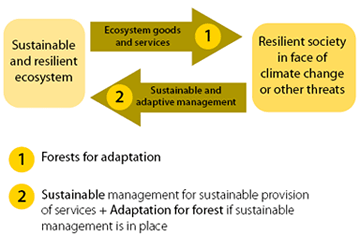
- CoFCCA
- Forest and adaptation
- Forests for adaptation
Forests for adaptation
Forest ecosystem services can help people adapt
Forests can help societies adapt to climate variability and change. Forests provide ecosystem services that contribute to reducing the vulnerability of sectors and people beyond the forestry sector. According to the Millennium Ecosystem Assessment, three types of ecosystem services directly contribute to human wellbeing: provisioning services (also called ecosystem goods), such as food and fuel; regulating services, such as regulation of water, climate, or erosion; and cultural services, such as recreational, spiritual, or religious services. Supporting services underpin the production of all other services.
Mangroves can protect coastal areas against storms and waves, which are predicted to become even more intensive with climate change and climate-induced sea-level rise. Forest products can provide safety nets to local communities when climate variability causes crop failures, and urban forests can reduce temperatures during heat waves.
The hydrological ecosystem services of forests (e.g. stormflow regulation, baseflow conservation) are of utmost importance in buffering the impacts of climate change. Forest cover in upper watersheds can increase infiltration of rainwater, reduce surface run-off and control soil loss, thus decreasing the destructive impacts of floodwaters. By storing run-off, forests can also act as natural water recharge areas by replenishing streamflows, which is of immense significance under the threat of increased drought.
Forest ecosystems also play an important role for the adaptation of national economic sectors. For example, the hydroelectric sectors of several Central American countries are directly dependent on hydrological forest ecosystem services such as the regulation of water quantity and the reduction in soil erosion and sedimentation.
Conversely, degraded forests and insecure flows of forest ecosystem services can make communities and sectors more vulnerable to climate variability and change and lead to increased adaptation costs.
Forest ecosystem services for the adaptation of people and sectors. Examples:
Soil conservation and hydroelectricity in Central America
- Increasing rainfall intensity and soil erosion.
- Increasing sedimentation in hydroelectric dams.
- Upstream soil conservation and forest protection: Part of adaptation.
Forests and local people in Central Africa
- Climate events affect local livelihoods.
- Some forest products, less sensitive than agriculture, are used as safety nets.
- Better forest management: Part of adaptation.
Mangroves and coastal areas in Southeast Asia
- Coast vulnerability (storms, waves, sea level rise).
- Protective role of mangrove + provision of goods.
- Better mangrove management: Part of adaptation.
Further reading: Locatelli, B, Kanninen, M, Brockhaus, M, Colfer, CJP, Murdiyarso, D & Santoso, H 2008, Facing an uncertain future: how forest and people can adapt to climate change, CIFOR, Bogor, Indonesia.
Ecosystem-based adaptation
Despite its name, ecosystem-based adaptation is actually an anthropocentric approach, where adaptation policies or measures consider the role of ecosystem services in reducing the vulnerability of society to climate change, through a multi-sectoral and multi-scale framework. Ecosystem-based adaptation also aims to reduce the vulnerability of ecosystems and their services to different threats, including climate change and land-use change. Strategies that aid the adaptation of ecosystems are needed to ensure the role of ecosystems for social adaptation.

Accordingly, the Convention on Biological Diversity defines the approach as the use of biodiversity and ecosystem services to help people adapt to the adverse effects of climate change. This may include sustainable management, conservation and restoration of ecosystems, as part of an overall adaptation strategy that takes into account the multiple social, economic and cultural co-benefits for local communities.
Ecosystem-based approaches to adaptation should be considered when designing adaptation portfolios and strategies. Maintaining nature’s capacity to buffer the impacts of climate change is often less costly than having to replace lost ecosystem functions with infrastructure or technology. Investments in ecosystems become even more attractive when the whole range of benefits is considered. Ecosystem-based adaptation also has the potential to align objectives that can otherwise be conflicting, such as poverty alleviation, development, biodiversity conservation, and climate change adaptation and mitigation. In addition, ecological infrastructure is often more adaptive than engineered infrastructure because ecosystem management can be modified more easily in the face of unexpected changes. The risks of mal-adaptation are thus minimal.
Further reading: Vignola, R, Locatelli, B, Martinez, C & Imbach, P 2009, ‘Ecosystem-based adaptation to climate change: what role for policy-makers, society and scientists?’, Mitigation and Adaptation Strategies for Global Change, vol. 14, pp. 691–696.


